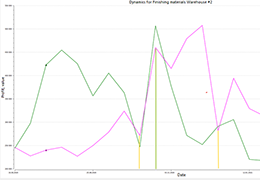As retail landscapes evolve, businesses constantly face the challenge of forecasting demand for their latest offerings. It's a perennial puzzle without a one-size-fits-all solution. Let's explore the diverse methods of forecasting.

The initial step is to categorize the types of new products. How do we introduce these fresh items into our lineup? Let's simplify by dividing them into three groups.
1. Assortment Rotation:
In this scenario, we swap out an existing product for a similar one. For instance, a new smartphone model hits the market, or a different brand of sugar replaces the previous one on grocery store shelves.
To forecast demand, we can analyze sales of similar past products. A simple and effective way to proceed with orders is to rely on the sales history of the old product until the new one has generated sufficient data.
Choosing a product with a comparable sales history can be done through expert judgment or software tools. In the latter case, your forecasting program may identify similar products based on specific parameters.
2. Assortment Expansion:
If we add a new product to a category that already exists, this is what will occur. For example, if we have a line of five yogurts with different flavors and decide to introduce a new flavor or consider adding yogurts from a different manufacturer.
Here, the situation is more complex. The total sales of yogurts with five flavors might be 100 units per day. Predicting how the new flavor will perform and its impact on sales cannot be determined by any expert or program alone.
There are two possible approaches:
- Calculate product sales percentage manually or with an auto-ordering program. Then, introduce another product to the group and determine the sales ratio for the expanded group of six items through expert judgment. This approach aids in making initial orders, which the user can fine-tune after. Past assortment expansions can serve as a reference for determining the size of the new order.
- When rotating the assortment, refer to the sales history of a similar product.
3. Completely New Product:
This involves introducing a product into our lineup for the first time.
If no analogs or similar products can be found, expert assessment becomes crucial. A knowledgeable specialist can estimate demand based on the product's properties and characteristics. The marketing department often provides initial forecasts, which can guide our ordering decisions.
After the initial batch, experts or algorithms, such as averaging, can be used to assess future orders.
As sales history accumulates, transitioning to advanced forecasting algorithms becomes feasible as periods of shortages are identified, such as probabilistic forecasting.
So, What Features Should the Inventory Management System Have to Handle New Products?
Now, let's consider the essential capabilities that a modern inventory management system should have to handle new products effectively:
- It identifies new products based on specific criteria, such as the number of days since the first sale.
- It employs dedicated algorithms for handling new products and selecting appropriate forecasting models for each product group.
- It utilizes the sales history of analogous products to forecast demand and inventory for similar products.
- It allows for setting an expected level of demand (initial stock) manually when future demand can only be determined through expert judgment.
- It provides a visual representation of new products for meticulous monitoring within a large assortment.



